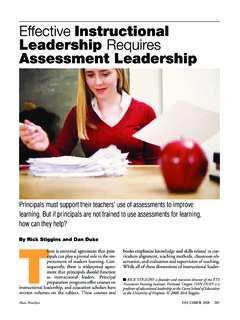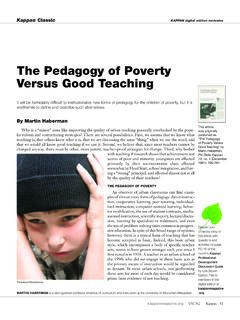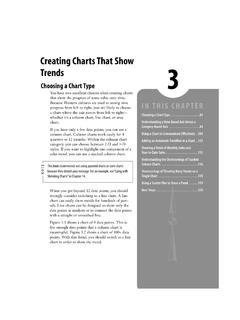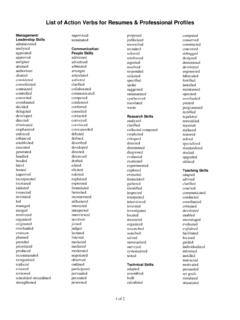Transcription of 5 Ways to Improve Tutoring Programs - IMPak · Login
1 Tutoring has become a familiar toolthat schools use to reinforce class-room teaching and Improve stu-dent achievement. That s espe-cially been the case because of NoChild Left Behind (NCLB) andits provisions for matter what the future holds for NCLB, prin-cipals and other educators will still need to know whatkinds of Tutoring are effective and for what and other educators will benefit fromlearning more about promising Tutoring practicesdrawn from the best available studies and field re-search (Gordon et al. 2007). What follows are practi-cal recommendations that educators can apply imme-diately to Improve school Tutoring Programs .
2 #1. USE A DIAGNOSTIC/DEVELOPMENTALTUTORING indicates that when individual diagnosisis structured into a Tutoring program, long-term stu-dent achievement increases. One effective way of ac-complishing this is by having the tutor observe andrecord student learning skills on a session-by-sessionbasis. This aids in a more accurate diagnosis of spe-cific learning disabilities (Vellutino et al. 1996).Accurate observation can guide the tutor in selectingshort diagnostic tests and exercises to better detail indi-vidual learning obstacles. Using a diagnostic/develop-mental approach will help the tutor discover underly-ing, perhaps subtle student cognitive processing issues,such as learning disabilities ( , dyslexia, visual/audi-tory perceptual issues, attention-span limitations, etc.)
3 (Gordon et al. 2004).#2. STRUCTURE THE Tutoring and implement a highly structured tutor-ing program for your school. This will help tutors im-plement more precise individualized Tutoring , ratherthan generic homework helper or drill-and-prac-tice Tutoring that provides little, if any, assistance inimproving student classroom achievement (Cohen,Kulik, and Kulik 1982; Ellison 1976; Rosenshine andFurst 1969; Wasik and Slavin 1993).One example of such a structured program used re-searched, field-based curriculum scripts to build skillcompetencies at an introductory, maintenance, or mas-tery learning level.
4 The Individualized Instructional5 ways to ImproveTutoring ProgramsEvidence on Tutoring points to practices that are found in the mostsuccessful Tutoring EDWARD E. GORDONn EDWARD E. GORDON is a researcher and author on diagnos-tic Tutoring . He taught at both DePaul University and Loyola Uni-versity Chicago and administered Imperial Tutoring and Educa-tional Services. His most recent book on Tutoring , co-authored withRonald R. Morgan, Charles J. O Malley, and Judith Ponticell, isThe Tutoring Revolution: Applying Research for best Practices,Policy Implications, and Student Achievement (Rowman & Lit-tlefield Education, 2007).
5 (e-mail: most promising results in improvinglong-term student achievement were seenin home-based Tutoring Programs . 440 PHI DELTA KAPPANP hoto: (IIP) systematically de-signed into its curricula more than300 learning descriptors to docu-ment academic skill achievement,specific learning-how-to-learn skills,and personal motivational curriculum scripts used a test-tutor-test approach by tracking tutorobservations session to session andusing shorter diagnostic/develop-mental measurement tools ratherthan lengthy diagnostic tests.)
6 Sincemany academically challenged stu-dents tend to exhibit test-phobic be-haviors, the results of this approachappear to be more accurate. (See Fig-ure 1.) Such an approach also has theadvantage of increasing tutorial in-structional time and reducing thetime spent on these structured Programs , tu-tors assessed students using learningdescriptors in one of 52 subject ar-eas. (See Figure 2.) On a one-to-onebasis, the typical Tutoring programincluded 25 one-hour sessions con-ducted over about 13 weeks. Or ona one-to-five basis, tutors conducted40 hours of instruction in two-hoursessions over about 10 weeks.
7 Thecurriculum-script method allowsthe tutor to follow a more thought-ful, sequentially arranged, system-atic Tutoring program based on awritten record, rather than on infor-mal guesswork. This helps minimizethe risk that an individual tutor willoverlook significant student learn-ing issues. Also, diagnosis becomesan ongoing process throughout theFEBRUARY 2009 441 FIG. 1 Example of Short Diagnostic ToolUsing the performance scale below, assess the student s skills after the 10thand 25th hours of DiscriminationDefinition: The ability to differentiate visually the formsand symbols in one s :Can match identical pictures and symbols such asabstract designs, letters, numbers, and :Prepare a page that has rows and columns of shapes orsymbols in which the symbol in the first column recurssomewhere in that row, such as:nlun w Observe the following in the student s writing.
8 Letter reversalword reversalletter confusionword confusionletter omissionword omissionletter substitutionword substitutionLearning DisabilitiesLearning StrengthsVery WeakWeakAverageStrongVery Strong123 45 HoursTutored1025 FIG. 2 Sample Learning Descriptors for Reading ComprehensionSkillVery WeakWeakAverageStrong Very StrongRating12345 HoursFinalSkillsTutoredGrade Level51020 AttainedTotal Comprehension1. Word Meaninga. Synonymb. Antonymc. Homonym2. Phrase and Sentence Meaning3. Following Directions4. Context Clues5. Key Words6. Topic Sentences7. Paragraph MeaningDiagnosis becomes an ongoing process throughout thetutoring session, rather than onlyduring a pretesting session, rather than only during a pretestingphase (Gordon, Morgan, and Ponticell 1995; Gordon1983; Morgan, Ponticell, and Gordon 1998).
9 #3. USE YOUR MOST EXPERIENCED TEACHERS AS TUTORS AND TRAIN trained tutors have consistently producedbetter Tutoring results. In general, tutors are effectivebecause they give students more personalized atten-tion. However, over time this effect tends to fade, andstudents resume their earlier learning habits. This iswhy the tutor s professional education, degrees, spe-cial credentials, prior professional experience, andspecialized training as a tutor can make a major dif-ference in ensuring that a student achieves betterlong-term learning gains (Mathes and Fuchs 1994;Shanahan and Barr 1995).
10 Finland has developed a highly effective system of tu-toring interventions to support all students. There is onespecially trained tutor for every seven classroom teach-ers. In any given school year, 30% of all elementary andhigh school students are tutored any time they are at riskof falling behind in their classroom Programs . Even thebest students are on occasion sent for Tutoring whenthey need additional instruction. This makes clear tostudents and parents that such Tutoring is not necessar-ily a sign of underperformance, but another part ofevery student s learning experience.














